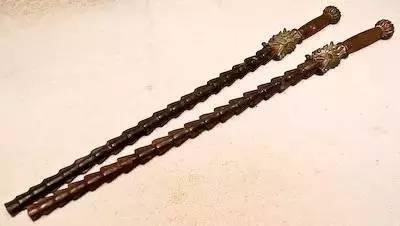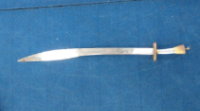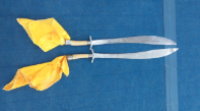Blades and Short Weapons
The difference between "short weapons" and "long weapons" is that short weapons are shorter than body length, and are usually wielded with one hand.
1.Sword Standard-issue, metal sword |
 Wooden sword Wooden sword |
Known as the "lord of all weapons", the sword is a double-edged strip of metal with a sharp point. In China the double-edged "sword" is different from the single-edged "dao" , or saber, which sometimes has a moderately curved blade unlike swords, which are always straight. The sword' s moveset consists of three primary moves: parry, slash, and stab. |
 |
The taiji sword is a type of sword used in Tai Chi training. Traditional swordsmanship and Tai Chi martial arts are combined in taiji sword techniques, which require the proper distribution of internal strength and not brute force to pull off. There are no forceful movements involved in the usage of the taiji sword; instead, great emphasis is put on the exertion of internal strength and the regulation of one' s breathing. |
 |
The whip is a Chinese short weapon; it has a longer history than most other weapons, already quite common during the Spring and Autumn period. Whips are also categorized into "hard" and "soft" -- hard whips are made of bronze or steel and resemble batons, while short whips are weaved of leather. The whip boasts a fairly versatile moveset; its techniques include the chop, sweep, stab, parry, as well as many more. |
| The Dao is a single-edged backsword that has a curved blade at times. During the Han dynasty, the dao became a common infantry weapon; many variants with long hilts also arose. Martial artists often describe the Dao as a "fierce tiger" , as opposed to the sword' s reputation as a "flying phoenix" -- this reflects how ferocious practicing with the dao should look like. Because of its many different variants, techniques for the dao vary greatly as well. If single-wielding, the other hand should move in coordination with the dao-wielding hand. Common single-wield techniques include the split, chop, stab, intercept, and upwards thrust. When dual-wielded, the dao requires excellent coordination between the two arms as well as the torso and legs. The arms must exert equal amounts of strength, and the body must be flexible. |
||
|
|
 Willow-leaf dao (named as such because of its moderately curved blade) |





